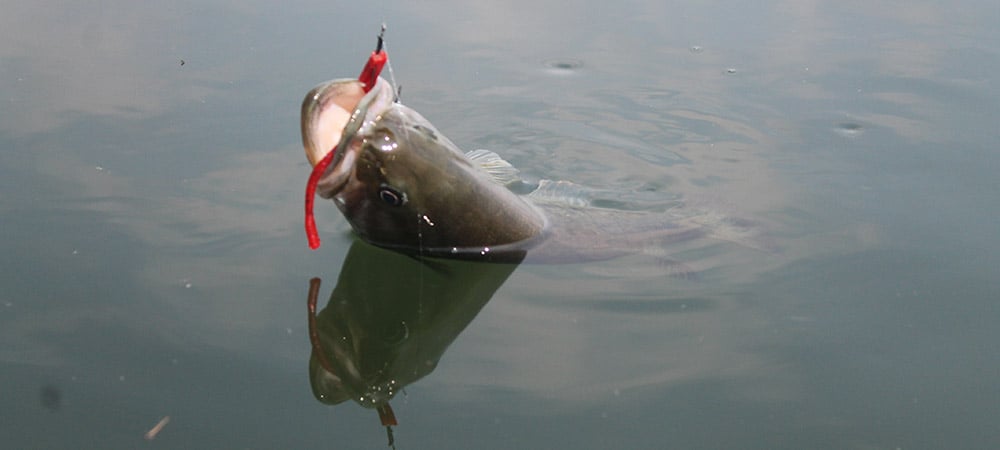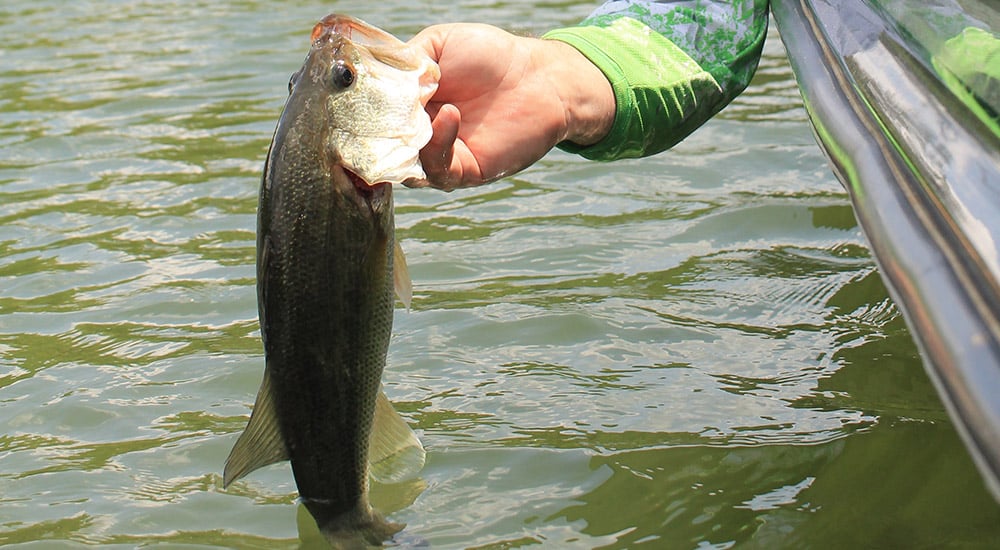Last Updated on
By Pete Rogers
The Largemouth bass, Micropterus salmoides, is the number one sought after game fish in the world. This one species alone accounts for $115 billion annually in the United States. Each year in the US, 47.2 million anglers are hitting the waters looking for fish, and the majority of these are looking for largemouth bass. Extrapolate that out and you find that anglers are spending an average of $400 dollars annually in search of largemouth bass.
The largemouth bass is not a true bass at all. Actually it is in the sunfish family. The largemouth is a prized trophy for many anglers. Found in every state with the exception of Alaska, this species is the most widely distributed freshwater fish in the world. It is found in more states, countries and continents than any other fish. Only the Brown Trout is a close rival when it comes to distribution globally. The largemouth is without question the number one game fish on the planet.
So how did the largemouth bass become the most widely distributed fish in the country? We can extend a hand of thanks to Spenser Fullerton Baird former curator of the Smithsonian. In the early 19th century as more and more settlers were moving west, he devised a plan to ensure their survival through fish. So every train that went west carried with them fish of many different species. These fish were released in every creek, pond, river and lake they could find. His brainchild of sending bass all across the country to feed the pioneers was the cause of the spread of the largemouth bass across the country. While other species were also distributed, the largemouth was one of the few that survived and thrived in the different claimants.
It is hard to fathom the number of fish that are taken annually in the United States. Some estimates place this number in the hundreds of millions. And with the pressure to catch big bass so strong, it is somewhat surprising that the world’s record for the largest largemouth of 22 pounds 4 ounces was set in 1932 at Montgomery Lake in Georgia by George Perry. This world record is arguably the most sought after record in the world.
The stories about Perry’s record are sketchy. There are no pictures of the fish, and no other accounts than Perry’s. Regardless, it stood alone at the top of the heap until July of 2009, when Manabu Kurita caught a 22-pound, 4.97 ounce largemouth from Japan’s Lake Biwa. Because International Game Fish Association rules require a record catch of less than 25 pounds to be surpassed by at least two ounces, Kurita’s catch is considered by the IGFA to be tied with Perry’s. Many argue that Kurita is the true record holder due to the details of the catch, the certified scales it was weighed on and the polygraph test Kurita took after the catch. But until there is a change in the policy, the IGFA lists them as tied.
Ken Duke, Managing Editor of Fishing Tackle Retailer is one of the most knowledgeable persons on largemouth bass in the world. Duke believes the popularity of the largemouth is attributed to two different elements. First Duke says: “Bass is popular because it is so widely distributed. And secondly, because you can find your own level with bass.” Duke explains that anyone with virtually any equipment can catch a bass. “Everything from a cane pole and night crawler sitting on the bank of a creek, all the way to anglers in six figure boats with the finest equipment made today, can catch largemouth bass.”
The other reason largemouth bass is so popular Duke believes is because the fish is so hardy. “It is a hardy tough fish that allows for tournaments.” He explains it like this; “Fishermen can fill their live well with five bass, keep them in there almost all day, take them to a weigh-in and when they are done, release them unharmed. It is the perfect tournament fish.”
Duke’s assessment of how to catch a bass is so true. The tackle industry focused solely on Largemouth Bass accounts for billions of dollars annually. Designing, testing and manufacturing lures to catch bass has a major economic impact all across the globe.
Largemouth Bass Fishing Tips
Let’s look at different fishing methods commonly used to catch largemouth bass.
Arguably the best lures to catch bass are soft plastics. Specifically the rubber worm. The rubber worm accounts for more catches than any other lure. Different sizes, shapes and colors are limitless. ZOOM Worm Company is the world’s number one manufacturer of soft plastics. Everything from four inch to 14 inch worms are available in a rainbow of colors. Ironically their number one seller was an accident. Green Pumpkin was derived by a change of colors and the two colors mixed and Green pumpkin was formed. Through the years, colors have changed and fads of colors have evolved. But one thing has remained, bass love plastic worms. Even with the array of colors available, many anglers believe that you cannot beat an 8 inch black worm for bass. Even Duke agrees: “You can’t go wrong with a black worm.”
Other than soft plastics, the lures move into two categories: hard plastics, and bladed spinner baits. Of these, the hard plastics are second in popularity. Rapala lures are perhaps the most popular. Their minnow is one of the best acting, maneuvering lure on the market, and dozens of companies have formed to try and mimic its action. Still Rapala dominates the market. Their Jerk baits, and “shad-Rap” lures have caught a legion of fish. Throwing something that looks a lot like what bass eat every day is a simple way to catch fish. From farm ponds to mammoth reservoirs, these baits will catch fish.
Bladed spinner baits come in a wide array of choices. From inline spinners to safety pin style, these flashy baits can catch fish. “The great thing about a spinner bait is that you can cover a lot of water fast, says Chase Simmemon of Fair Play, SC. Simmemon has won many local tournaments and is known for catching fish when no one else can. “A spinner bait is looking for a ‘reaction strike,’” Simmemon says. The lure doesn’t represent anything the fish eats normally, but the flash of the blades resemble the reflection of bait fish. When it moves close to a bass, the bass reacts to the bait and strikes at it.
Duke adds: “If there is one more thing that can be added to the largemouth, it is that you can go out on any day of the year and catch a largemouth bass. From the deepest of winters to the hottest of summers the angler never has to rest. In fact, the Massachusetts state record largemouth was caught on a frozen lake while ice fishing.”
Being able to catch a specific species any day of the year, with virtually any bait in any water across the country makes the bass a formidable foe.
Everyone likes to catch big bass. Even with the world’s record topping 22 pounds, the measuring rod for a trophy is barely half that size. For most the 10 pound bass is a true trophy. Personally, I still am striving for a bass over ten pounds. I have caught over sixty fish over eight pounds, and forty one fish that weigh over nine pounds. The ten pound fish eludes me. Perhaps this is what the drive is, to chase and catch a bass bigger than you have ever caught.
Whatever the lure of the bass is, whatever the passion that drives people to spend hundreds and thousands of dollars and hours in pursuit, one thing is for sure – the largemouth is here to stay. If you want to catch a fish, find a creek, pond or lake and there are bass to be caught.















